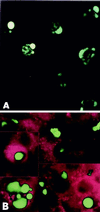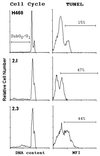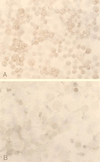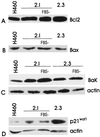The tumor-suppressor gene FHIT is involved in the regulation of apoptosis and in cell cycle control
- PMID: 10411902
- PMCID: PMC17543
- DOI: 10.1073/pnas.96.15.8489
The tumor-suppressor gene FHIT is involved in the regulation of apoptosis and in cell cycle control
Abstract
Alteration of the FHIT (fragile histidine triad) gene occurs as an early and frequent event in lung carcinogenesis. FHIT gene transfer into lung cancer cell line H460 lacking Fhit protein expression resulted in reversion of tumorigenicity. To gain insight into the biological function of FHIT, we compared the H460 cell line with its Fhit transfectants (H460/FHIT). A significant inhibition of cell growth was observed in H460/FHIT cells. The analysis of apoptosis by in situ terminal deoxynucleotidyltransferase-mediated dUTP nick end labeling revealed a high rate of apoptosis-induced DNA strand breaks in stable clones. In situ results were confirmed by FACScan analysis that showed an apoptotic rate of 44-47% compared with a 15% level in the control H460 cells. Analysis of cell cycle-phase distribution indicated a significant G(0)/G(1) arrest and the presence of a sub-G(1) peak in the stable clones. No significant changes in Bcl2, BclX, and Bax protein expression level were observed in the transfected clones as compared with the control H460 cells whereas a 2-fold increase in Bak protein levels was noticed. An increased level of p21(waf) protein paralleled by an up-regulation of p21(waf) transcripts also was found in Fhit-expressing clones compared with the H460 cell line. No differences in p53 levels were observed in the same cells, suggesting a p53-independent effect. These data suggest that the observed growth-inhibitory effect in FHIT-reexpressing cells could be related to apoptosis and cell cycle arrest and link the tumor-suppressor activity of FHIT to its proapoptotic function.
Figures





References
-
- Ohta M, Inoue H, Cotticelli M G, Kastury K, Baffa R, Palazzo J, Siprashvili Z, Mori M, McCue P, Druck T, et al. Cell. 1996;84:587–597. - PubMed
-
- Sozzi G, Tornielli S, Tagliabue E, Sard L, Pezzella F, Pastorino U, Minoletti F, Pilotti S, Ratcliffe C, Veronese M L, et al. Cancer Res. 1997;57:5207–5212. - PubMed
-
- Sozzi G, Pastorino U, Moiraghi L, Tagliabue E, Pezzella F, Ghirelli C, Tornielli S, Sard L, Huebner K, Pierotti M A, et al. Cancer Res. 1998;58:5032–5037. - PubMed
-
- Hadaczek P, Siprashvili Z, Markiewski M, Domagala W, Druck T, McCue P A, Pekarsky Y, Ohta M, Huebner K, Lubinski J. Cancer Res. 1998;58:2946–2951. - PubMed
-
- Greenspan D L, Connolly D C, Wu R, Lei R Y, Vogelstein T C, Kim Y T, Mok J E, Munoz N, Bosch X, Shah K, et al. Cancer Res. 1997;57:4692–4698. - PubMed
Publication types
MeSH terms
Substances
Grants and funding
LinkOut - more resources
Full Text Sources
Research Materials
Miscellaneous

